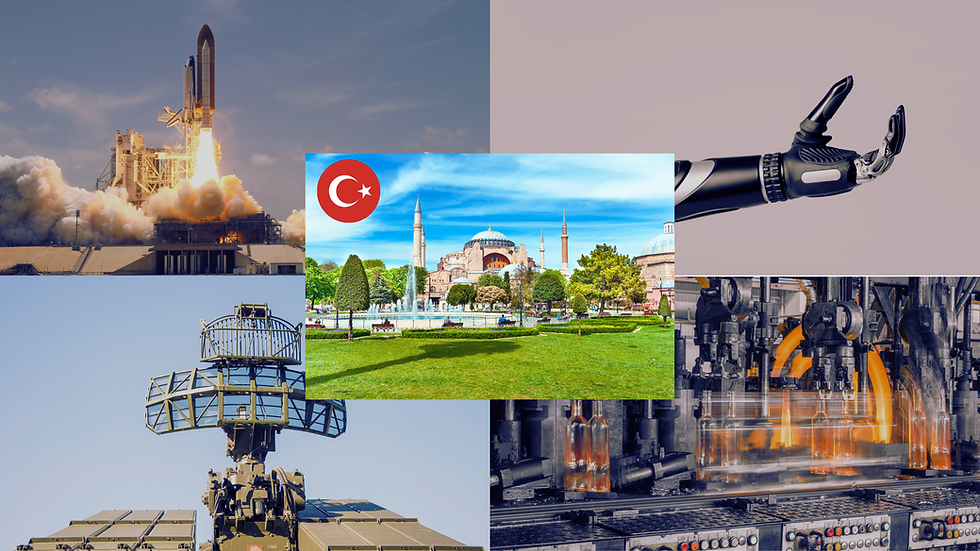3D Printing Now: Breaking Limits in Aerospace, Medicine, and Materials – Mid-2025 Update
- Gökhan Gönültas

- Jun 30
- 4 min read
The Current Landscape of 3D Printing
3D printing—or additive manufacturing (AM)—is no longer confined to prototyping or niche projects. Today, it’s enabling engineers to test spacecraft components, helping surgeons prepare for complex reconstructions, and allowing designers to create forms never possible before. And it’s doing all of this with increasingly sustainable materials, more accessible equipment, and smarter design tools.
Let’s take a closer look at the biggest shifts happening right now.
Aerospace & Defense: Speed, Lightness, and Precision
The aerospace sector continues to lean into 3D printing to solve long-standing challenges. In recent months, there’s been a successful test of a fully 3D-printed rocket engine—an achievement that highlights the growing reliability of AM in extreme environments.
Meanwhile, defense strategies are evolving to incorporate 3D printing as a critical enabler of rapid manufacturing and field readiness. The push isn't just for rapid part replacement, but for developing complex, lightweight structures using materials like magnesium—known for its high strength-to-weight ratio but historically difficult to manufacture conventionally. 3D printing is cracking open this frontier, allowing for faster innovation and deeper customization in performance-critical parts.

Healthcare & Human-Centered Innovation
In Latin America, 3D printing is becoming a lifeline for medical care in underserved regions. Recent breakthroughs in reconstructive surgery using patient-specific models and implants have transformed access to advanced treatments. These innovations are not only saving time and cost, but also improving clinical outcomes by creating customized solutions tailored to each patient's anatomy.
Beyond surgery, the potential for bioprinting and anatomical modeling continues to grow, helping doctors simulate procedures before ever touching a scalpel. As affordability improves, these technologies are moving from high-end hospitals to more widespread applications.
Material Science: From Metal Filaments to Room-Temperature Glass
Material development is the silent engine behind 3D printing’s rapid growth, and the last few months have seen some bold leaps.
A new stainless steel filament has been released that simplifies metal printing on widely available desktop printers. This could open up metal 3D printing to a much broader group of users, including educators and small businesses.
Researchers are now exploring room-temperature glass printing—a breakthrough that could reshape not only artistic production but also optical and architectural manufacturing. If scaled, this technique could make glass-based 3D printing more energy-efficient and accessible than ever before.
Meanwhile, interest in ceramic 3D printing is intensifying. Ceramic materials—due to their resistance to heat and wear—are being developed for demanding applications such as aerospace, medical implants, and high-end electronics.
Design & Architecture: Function Meets Form
3D printing continues to inspire a new era of functional, minimalist, and organic product design. Chairs, fashion accessories, and building components are being optimized using generative algorithms that mimic natural structures like bone or coral—balancing strength, flexibility, and aesthetics.
What makes this movement even more compelling is that the outputs aren’t just futuristic-looking—they’re also resource-efficient. 3D printing allows designers to use less material, reduce production steps, and avoid waste entirely by only producing what's needed.
Technology’s Direction: Smarter, Faster, More Sustainable
Looking forward, the evolution of 3D printing will revolve around three main pillars:
1. Decentralized & Agile Manufacturing
The ability to produce components on-site—in factories, hospitals, or even in disaster zones—is changing how we think about supply chains. This means faster turnaround, fewer dependencies, and better resilience in times of disruption.
2. Cross-Disciplinary Collaboration
Success in 3D printing today comes from blending disciplines. Engineers are working with surgeons, artists with AI developers, and aerospace designers with material scientists. This convergence is driving a new generation of hybrid solutions.
3. Democratization of Technology
With easier-to-use materials and more affordable printers, entry barriers are falling. Advanced applications—once limited to high-end labs or massive corporations—are now available to small studios, clinics, and educators.

What’s Next?
The trends we’re seeing now point toward a near future where:
Rocket parts are printed and tested within weeks, not months.
Implants are tailor-made for patients in local clinics.
Buildings are printed from bio-based or recycled materials.
Functional components are produced at the point of need using common desktop machines.
Innovation is pushing 3D printing beyond the lab and into the everyday. And with advances across materials, process control, and sustainability, this momentum is only accelerating.
A Note on Global Impact
As the ecosystem matures, different regions are stepping into leadership roles. Europe is advancing ceramic and sustainability-focused solutions. Latin America is pioneering cost-effective medical applications. And the Asia-Pacific region is pushing the limits of high-speed, high-volume manufacturing.
Türkiye, uniquely situated at the intersection of East and West, holds strategic potential to connect innovation with industry. With its strong manufacturing heritage and growing tech ecosystem, Türkiye could play a vital role in shaping how global additive manufacturing scales in the years to come.
Final Word
3D printing in mid-2025 is more than just a manufacturing method—it’s a platform for innovation, resilience, and creativity. Whether it’s enabling life-saving surgeries, optimizing aerospace designs, or experimenting with new materials, additive manufacturing is leaving its mark.
And the most exciting part? We're only scratching the surface.

